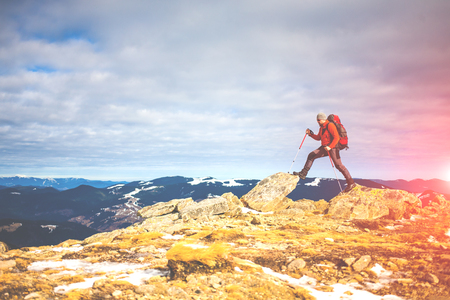Understanding Altitude Training
If you’re planning to tackle high-elevation hikes in U.S. national parks like Rocky Mountain, Yosemite, or Grand Teton, understanding altitude training is a game changer. Altitude training refers to preparing your body to perform at its best in environments where the air is thinner and oxygen levels are lower than what you’re used to at sea level. This type of training is especially important for hikers because trails in many American parks often reach elevations that can challenge even seasoned adventurers. By incorporating altitude training into your pre-hike routine, you help your body adapt gradually—reducing the risk of altitude sickness and enhancing your stamina for those breathtaking summit views. Whether you’re a weekend explorer or gearing up for an epic backcountry trek, learning about altitude training is the first step toward safer and more enjoyable adventures above the tree line.
Benefits for Hikers
When it comes to preparing for a challenging hike, integrating altitude training into your pre-hike routine can be a true game-changer. Altitude training exposes your body to lower oxygen levels, which prompts several physiological adaptations. These changes not only enhance your hiking performance but also make high-elevation adventures more enjoyable and less taxing on your body.
Physiological Advantages of Altitude Training
One of the main benefits of altitude training is improved stamina. As you train in an environment with reduced oxygen, your body compensates by increasing red blood cell production. This allows you to carry more oxygen in your bloodstream, resulting in greater endurance during long or steep hikes. Additionally, altitude training boosts your muscles’ ability to use oxygen efficiently, making it easier to tackle strenuous trails without feeling winded.
Key Performance Benefits
| Benefit | Description | Impact on Hiking |
|---|---|---|
| Increased Stamina | Your body produces more red blood cells, improving oxygen delivery to muscles. | You can hike longer distances and recover faster during breaks. |
| Better Oxygen Utilization | Your muscles adapt to work efficiently with less oxygen. | You feel less fatigued on steep ascents or at higher elevations. |
| Enhanced Recovery | Improved circulation helps flush out metabolic waste products faster. | Post-hike soreness and recovery time are reduced. |
Cultural Relevance for American Hikers
For hikers exploring high-altitude trails in the U.S.—from Colorado’s Fourteeners to California’s Sierra Nevada—these benefits directly translate to safer and more successful adventures. By making altitude training part of your preparation, you’ll find yourself better equipped to handle the physical demands and enjoy America’s most breathtaking landscapes with confidence.

3. Types of Altitude Training Methods
When preparing for a high-elevation hike, you don’t necessarily need to live in the Rockies or have access to a professional training center. There are several accessible ways to integrate altitude training into your routine that fit American lifestyles and local resources. Below are some practical options to get you started.
Using Local Gym Equipment
Many gyms across the U.S. now offer equipment and classes designed to simulate altitude conditions. Look for treadmills or stationary bikes with built-in altitude simulation features, which limit oxygen intake to mimic higher elevations. Interval training on stair climbers or ellipticals is another excellent way to boost cardiovascular strength, even at sea level. If your gym offers group fitness classes like HIIT (High-Intensity Interval Training), these can also help increase your endurance and lung capacity, making them a valuable part of your pre-hike regimen.
Simulated Environments
If you’re seeking a more advanced approach, some athletic centers provide hypoxic rooms or altitude tents. These environments reduce the oxygen concentration in the air, closely mirroring what you’d experience at elevation. While not as widely available as standard gym equipment, these facilities are becoming more common, especially in cities near popular hiking destinations. Renting an altitude tent for home use is another option if you’re looking for maximum flexibility—just make sure to follow all safety guidelines and consult with a professional trainer.
Weekend Trips to Higher Elevations
If you live within driving distance of mountainous areas like the Sierra Nevada, Appalachians, or even local hills above 5,000 feet, consider planning regular weekend hikes or overnight stays at higher altitudes. Gradually exposing your body to thinner air helps build acclimatization over time without disrupting your weekly schedule. Many Americans incorporate these micro-adventures into their routines by joining hiking clubs or organizing family camping trips—a fun way to train while enjoying nature and building community.
Combining Methods for Best Results
For most hikers, a mix of these methods works best. Try alternating between gym-based workouts during the week and outdoor elevation exposure on weekends. Remember, consistency is key: even small adjustments in your routine can make a big difference when it’s time to hit the trail at altitude.
4. Sample Pre-Hike Altitude Training Plan
Getting ready for high-altitude adventures in iconic American ranges like the Rockies or the Sierra Nevada means preparing your body for thinner air and increased physical demands. To help you safely build altitude tolerance, here’s a beginner-friendly training plan designed to fit into your pre-hike routine. This schedule gradually increases exposure to simulated altitude conditions and boosts cardiovascular strength, so you can make the most of your mountain experience.
Week-by-Week Altitude Acclimation Schedule
| Week | Training Focus | Activity Suggestions | Notes |
|---|---|---|---|
| 1 | Base Endurance | Moderate hikes at local parks (2-4 miles), brisk walking, or light jogging 3x/week | Focus on steady pace and building aerobic capacity |
| 2 | Elevation Gain Practice | Add stair climbing, hill sprints, or hiking trails with 300–500 ft elevation gain 2x/week; continue base cardio 1–2x/week | Prioritize uphill movement to mimic mountain terrain |
| 3 | Simulated Altitude Exposure | If available, use a gym altitude mask or train in higher-elevation areas nearby; increase hike length to 5–7 miles once weekly; maintain other workouts | If no altitude access, focus on increasing intensity and duration of workouts |
| 4 | Back-to-Back Workouts | Complete two consecutive days of hiking or cardio activity, including one with significant elevation gain (700–1000 ft) | This builds stamina and mimics multi-day hikes common in US national parks |
| 5+ | Taper & Recovery with Altitude Simulation | Reduce overall mileage but maintain elevation training; take a short trip to a higher elevation location if possible (e.g., visit a ski town or mountain trailhead for a day hike) | Aim for an overnight stay at moderate altitude before your main hike if possible for real acclimatization benefits |
Extra Tips for Popular Destinations
- The Rockies: Many trailheads start above 8,000 feet—plan at least one night at moderate elevation prior to your big hike.
- Sierra Nevada: Elevation gains are often steep—incorporate resistance training to strengthen legs and core for rocky ascents.
- General: Always listen to your body—if symptoms of altitude sickness appear during training (headache, nausea, dizziness), reduce intensity and consult a medical professional if needed.
The Takeaway: Consistency is Key!
This sample plan blends endurance, elevation, and simulated altitude training to help you thrive on America’s favorite high-country trails. Stick with it, and you’ll arrive at your adventure feeling strong, confident, and ready to enjoy every mile above the clouds.
5. Safety Tips and Common Risks
Know Your Limits: Listen to Your Body
When incorporating altitude training into your pre-hike routine, self-awareness is essential. American hikers often emphasize “listening to your body”—pay attention to symptoms like headaches, dizziness, nausea, or unusual fatigue. These may signal the early onset of altitude sickness. If you notice any of these warning signs, slow down, rest, or descend if symptoms persist. Always remember that the mountain will still be there another day, but your health comes first.
Avoiding Altitude Sickness
Altitude sickness can affect anyone, regardless of fitness level. To minimize risks, increase your elevation gradually during both training and the actual hike. The common practice among U.S. hikers is to follow the “climb high, sleep low” rule whenever possible—train at a higher elevation but return to lower altitudes to rest. Stay well-hydrated and avoid alcohol and excessive caffeine before and during your hikes, as these can worsen dehydration and symptoms.
Safe Altitude Training Practices
Start altitude training with short sessions and low intensity. Gradually ramp up duration and difficulty as your body adapts. Many experienced American hikers recommend spending at least a few hours at moderate elevations (5,000–8,000 feet) on weekends or during extended workouts. It’s also wise to train with a partner or in groups for added safety and support.
Best Practices from Seasoned Hikers
Plan for recovery days between intense altitude sessions to allow your body to adjust naturally. Pack extra snacks rich in carbohydrates since your metabolism speeds up at altitude. Familiarize yourself with emergency protocols specific to the areas you’ll be hiking—knowing when to call for help can make all the difference in critical situations.
By following these safety tips and staying mindful of common risks, you can integrate altitude training into your pre-hike routine confidently and responsibly—setting yourself up for a successful and safe adventure on America’s beautiful trails.
6. Bringing Altitude Training to Your Local Community
One of the most rewarding aspects of preparing for a hike—especially when altitude training is involved—is connecting with others who share your passion for the outdoors. In the U.S., local hiking groups and outdoor communities are thriving, offering support, motivation, and valuable resources for every level of hiker.
Join or Start a Hiking Group
Begin by searching for established hiking clubs or outdoor fitness groups in your area. Organizations like the Sierra Club, Meetup, and REI Co-op regularly host group hikes and training sessions, making it easy to find people with similar goals. If you don’t see a group that fits your needs, consider starting your own! Use social media platforms or community boards at local outdoor stores to attract members who are interested in altitude training and pre-hike preparation.
Leverage Local Resources
Your community likely has more resources than you realize. Check out recreation centers for fitness classes tailored to hikers or inquire about altitude simulation equipment at nearby gyms. Public parks, nature preserves, and even urban staircases can serve as creative venues for your training sessions. Don’t hesitate to ask park rangers or local outfitters for tips on trails with elevation gain—they often have insider knowledge that can enhance your routine.
Share Your Progress and Inspire Others
Documenting your altitude training journey not only keeps you accountable but also encourages others in your community. Share updates on group message boards, create posts on Instagram or Facebook using popular hiking hashtags, or write short blog entries detailing your experiences and breakthroughs. Celebrate milestones together, whether it’s conquering a tough trail or reaching a new personal best during a simulated session. By fostering an open and supportive environment, you’ll help build a culture where everyone feels empowered to take on new challenges—and enjoy safer, more successful hikes at higher elevations.


